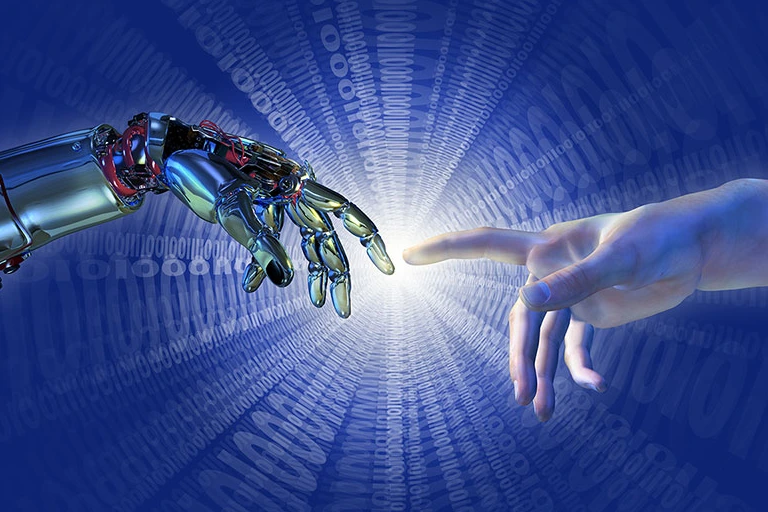Introduction
Artificial Intelligence (AI) has been rapidly evolving, reshaping industries and societies worldwide. This article delves into the multifaceted aspects of AI evolution, addressing concerns related to fears, bias, security, and efficiency.
Artificial Intelligence (AI) has changed our lives and jobs a lot. In this article, we’ll talk about how AI developed over time and look at issues like fears, bias, security, and the desire to be more efficient. AI has a long history, starting with basic reasoning and reaching today’s advanced machine learning.
Exploring this history helps us see the ups and downs that influenced AI. From computers playing chess to understanding human language, important moments show how AI has grown. Knowing about these big steps is important to understand where AI is now.
Understanding AI Evolution
In movies and TV shows, AI is sometimes shown in ways that aren’t true. It’s important to know what’s real and what’s not to avoid unnecessary worries. Even though some fears about AI are not needed, there are real concerns, like losing jobs and doing things that might not be right.
To deal with these worries, we need to be careful and smartly think about them. Learning about AI, or AI literacy, is a strong tool to help people understand the technology better. This way, we can have a society that knows more and feels more comfortable with AI.
Addressing Bias in AI
AI systems can be unfair without meaning to, and this can happen by mistake or in a regular way. The first thing we need to do is figure out and understand these unfair things. From algorithms that treat people unfairly to keeping certain ideas going, these problems from bias in AI can affect a lot of things.
It’s really important to find and fix these issues to make sure AI is fair and good. Using different types of information, being clear about how the system works, and keeping an eye on things all the time are important ways to make sure AI is fair and doesn’t have bias. These steps help make AI systems that treat everyone equally.
Ensuring Security in AI Systems
As AI becomes a big part of important systems, there are more challenges to keeping everything safe from cyber problems. It’s really important to know about these challenges so we can protect against possible issues. If AI systems are not secure, bad things can happen, like people getting access to information they shouldn’t or decisions being affected.
Making security a top priority is really important when we’re creating and using AI. Using codes to keep information safe, checking things often, and having strong ways to confirm someone’s identity are some of the best ways to make sure AI systems stay secure.
Enhancing Efficiency through AI Evolution
AI is good at making things easier. It can do tasks on its own and make everything work better. This helps a lot in different jobs. Looking at examples in the real world, like in healthcare and managing supplies, we can see how AI makes things more efficient. AI is like a helper that makes industries work better, and seeing these examples shows us how good it is.
When we talk about how well language models understand things, there’s a concept called “perplexity.” It’s like a measure of how sure or unsure the models are. Another thing, called “burstiness,” is about how things happen in a not-so-regular way. Finding the right balance between these two is important for making sure AI models work well in different situations. It’s a bit tricky, but developers need to figure it out to make AI systems that are both versatile and accurate.
The Human Touch in AI Evolution
As AI gets better, it’s really important to think about what’s right and fair. This means dealing with things like privacy, responsibility, and being open about how AI works. Instead of taking over from people, AI can be a great partner to help us. When we look at how people and AI can work together, it shows that they can make each other even better. Keeping a focus on what’s important to people makes sure that when we make AI, we do it in a way that follows the rules.
It’s like finding the right balance between making cool new things with technology and doing it in a way that’s fair and responsible. When we talk about AI, it’s a good idea to tell stories that people can relate to and understand. And, when we use simpler words and easily explain things, more people can get what AI is all about.
Active Voice and Rhetorical Questions in AI Content
When we talk about AI, it’s better to use words that show action and make things clear and interesting. When information is presented in a way that sounds like someone is doing something, it’s more engaging. Asking questions that make you think about what you’re reading is a good way to make learning more interesting.
It’s like having a conversation, using words that are easy to understand. We don’t need to use too many big or serious words; it’s better to keep things friendly and make it easier for everyone to get what we’re talking about.
Analogies and Metaphors in AI Communication
Comparing AI ideas to things we know, like using stories or examples, helps make it easier to understand. It’s like finding everyday situations that are a lot like what AI does. This way, we can talk about AI in a way that feels familiar.
When we use these comparisons, it’s like giving real-life examples to help people understand what might seem a bit tricky at first. Doing this helps everyone feel more sure and interested in AI.
The Importance of Specificity and Context
Sharing a lot of details about AI helps people get what it’s all about. When we give more information, it adds to what readers know and helps them smartly talk about AI. It’s important not to say things that are too general, so everything stays correct and true.
Talking about specific things in AI stops people from getting confused and helps them see the whole picture. Connecting what we say about AI to things that happen in real life makes the information more important and useful. It’s like making AI make sense in our everyday world.
Conclusion
AI growing means there are lots of things it can do, but there are also important problems to solve. We need to deal with worries, fix unfairness, make sure things are safe, and make AI work well.
By doing this, we make sure AI helps us in a good way. As we figure out how to make AI better, it’s important to keep it friendly and help people get what it’s all about. We want everyone to really understand this amazing technology and use it in a way that helps us all.
FAQ’s
1. Is AI evolving too fast for society to keep up?
Ans: AI evolution poses challenges, but a balanced approach and ongoing education can help society adapt.
2. How can individuals contribute to addressing bias in AI?
Ans:Supporting diverse AI development teams, advocating for transparency, and staying informed are impactful contributions.
3. What role does cybersecurity play in the responsible use of AI?
Ans:Cybersecurity is crucial for safeguarding AI systems against potential threats, and ensuring responsible and secure deployment.
4. Can AI truly collaborate with humans, or will it replace jobs?
Ans:AI can enhance human capabilities and create new opportunities, emphasizing collaboration over replacement.
5. Where can I learn more about the latest developments in AI?
Ans:Stay informed through reputable sources, attend conferences, and engage with online communities to stay updated on AI advancements.
More Information : The History and Evolution of Artificial Intelligence, AI’s Present and Future







